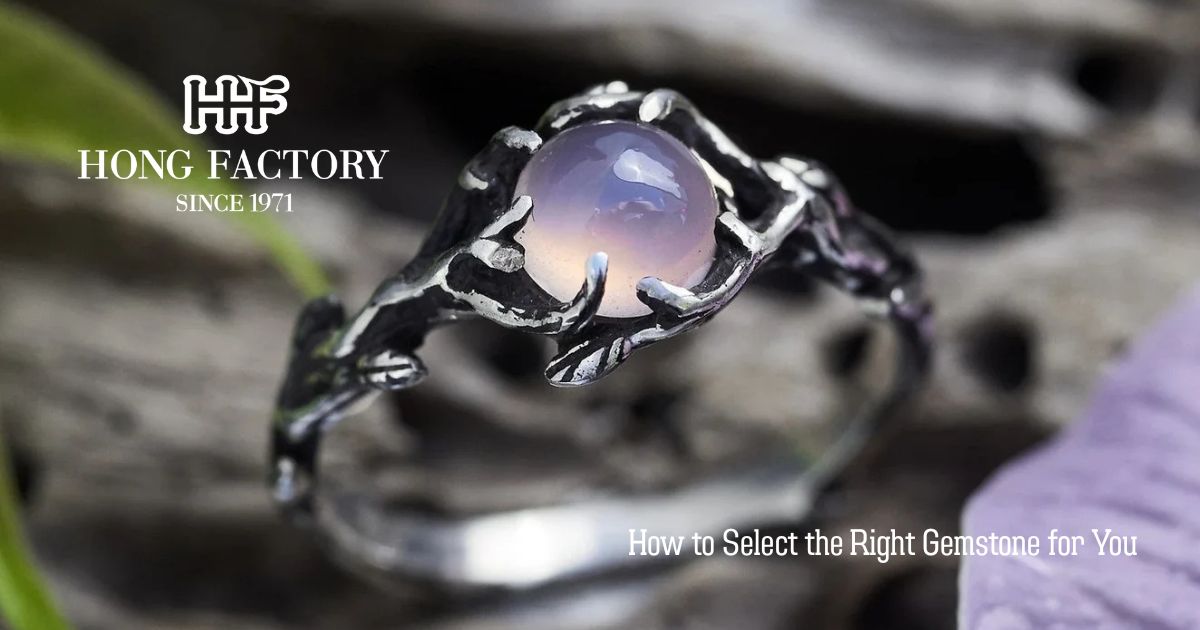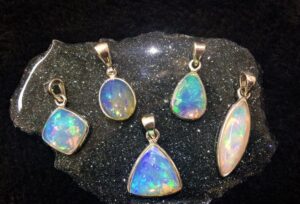Choosing the right gemstone is a personal and meaningful decision that goes beyond aesthetics. Whether you are selecting a gemstone for an engagement ring, a statement piece, or a meaningful accessory, understanding the properties, symbolism, and durability of different gemstones can help you make an informed choice. This guide explores the key factors to consider when selecting the perfect gemstone for your jewelry.
How to Select the Right Gemstone for You

1. Consider Your Personal Style
Your personal style plays a significant role in determining which gemstone is right for you. The right gemstone should complement your wardrobe and overall aesthetic.
- Classic and Elegant: Diamonds, pearls, and sapphires offer timeless appeal. These stones work well with traditional and formal outfits.
- Bold and Statement-Making: Rubies, emeralds, and black diamonds add drama and uniqueness. Ideal for those who love making a statement with their accessories.
- Minimalist and Modern: Aquamarine, morganite, and topaz provide a sleek, contemporary look. These gemstones are perfect for understated yet sophisticated styles.
- Bohemian and Nature-Inspired: Opals, turquoise, and moonstones align with earthy aesthetics. These stones pair beautifully with natural textures and flowing fabrics.
- Vintage Enthusiasts: Garnets, amethysts, and antique-cut diamonds evoke a sense of old-world charm.
2. Choose a Gemstone Based on Meaning and Symbolism
Many gemstones carry historical, spiritual, and emotional significance. Understanding the meaning behind each gemstone can make your choice even more special.
- Diamond: Symbolizes love, strength, and eternity. Often used in engagement rings as a symbol of commitment.
- Ruby: Represents passion, vitality, and success. Historically worn by royalty as a sign of power.
- Sapphire: Associated with wisdom, loyalty, and protection. A popular choice for engagement rings, notably worn by Princess Diana.
- Emerald: Symbolizes growth, fertility, and harmony. Known for its deep green hue and connection to nature.
- Amethyst: Known for calming energy and spiritual clarity. Believed to aid in stress relief and meditation.
- Citrine: Represents joy, prosperity, and creativity. Often associated with positive energy and financial abundance.
- Aquamarine: Symbolizes serenity and courage. Once thought to be a lucky stone for sailors.
- Moonstone: Represents intuition and feminine energy. Often worn as a good luck charm.
- Tourmaline: Believed to inspire creativity and emotional balance.
3. Assess Durability and Wearability
Not all gemstones are created equal in terms of hardness and durability. If you plan to wear your gemstone frequently, consider how well it will hold up over time.
- Mohs Hardness Scale: This scale measures the hardness of gemstones from 1 (softest) to 10 (hardest). The higher the number, the more resistant the stone is to scratches and damage.
- High-Durability Stones (8-10 on Mohs Scale): Diamonds, sapphires, and rubies are excellent choices for engagement rings and everyday wear.
- Medium-Durability Stones (6-7.5 on Mohs Scale): Garnet, topaz, and peridot require some care but can be worn regularly.
- Delicate Stones (2.5-5.5 on Mohs Scale): Pearls, opals, and turquoise are soft and best suited for occasional wear.
- Protective Settings: Softer gemstones should be set in protective settings like bezels or halos to minimize exposure to damage.
4. Select a Gemstone Based on Color Preference
Color is often the deciding factor when selecting a gemstone. Different gemstones come in a variety of hues, allowing for personal expression.
- Cool Tones: Blue sapphires, aquamarine, and tanzanite complement cooler skin tones.
- Warm Tones: Citrine, garnet, and yellow sapphire enhance warmer skin tones.
- Neutral Tones: Diamonds, pearls, and champagne-colored stones suit all complexions.
- Multicolored Stones: Alexandrite, opal, and tourmaline offer shifting hues that create a unique look.
- Rare Colors: Some gemstones, like Padparadscha sapphires (pink-orange) and Paraiba tourmalines (neon blue-green), are highly sought after for their rarity.
5. Consider Ethical and Sustainable Choices
With growing awareness about ethical sourcing and sustainability, consider choosing responsibly sourced gemstones.
- Lab-Grown Gemstones: These provide an environmentally friendly and conflict-free alternative to natural stones. Lab-grown diamonds and sapphires offer identical beauty at a lower cost.
- Recycled or Vintage Stones: Repurposing antique gemstones reduces environmental impact while adding historical charm.
- Fair Trade and Ethical Sourcing: Look for certifications that ensure responsible mining practices and fair wages for workers.
- Conflict-Free Diamonds: Diamonds certified by the Kimberley Process ensure they are ethically sourced.
- Recycled Metals: Many jewelers now offer rings and settings made from recycled gold or platinum.
6. Work with Your Budget
Gemstone prices vary based on rarity, size, and quality. Consider these options when making a budget-conscious choice:
- Affordable Alternatives: Moissanite offers brilliance similar to diamonds at a fraction of the cost.
- Rarity and Price Factors: Some stones, like alexandrite and natural blue sapphires, are rare and command higher prices.
- Investment-Worthy Stones: High-quality rubies, sapphires, and emeralds tend to hold or appreciate in value over time.
- Opt for Smaller Carat Weights: A well-cut gemstone can maximize brilliance even at a smaller size.
- Prioritize Cut Over Carat: A beautifully cut stone will appear more brilliant, even if it’s slightly smaller.
7. Buying and Caring for Your Gemstone Jewelry
Once you’ve selected the perfect gemstone, ensure that you purchase from a reputable source and care for it properly.
- Buy from Certified Jewelers: Look for retailers that offer GIA, AGS, or IGI certifications.
- Ask About Treatments: Some gemstones are heat-treated or enhanced—ensure you know what you’re purchasing.
- Proper Cleaning: Use a soft brush, mild soap, and lukewarm water to clean most gemstones. Pearls and opals require special care.
- Store Carefully: Keep softer stones separate from harder gemstones to prevent scratches.
- Regular Maintenance: Have prongs and settings checked periodically to ensure stones are secure.
Selecting the right gemstone involves a balance of aesthetics, durability, symbolism, and budget. Whether opting for a traditional diamond, a meaningful birthstone, or an ethical alternative, the right gemstone will enhance both your jewelry collection and personal style.
By considering factors like durability, color preference, and ethical sourcing, you can confidently choose a gemstone that aligns with your values and lifestyle.



